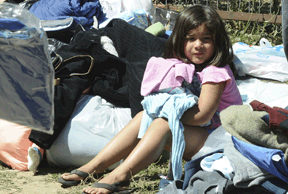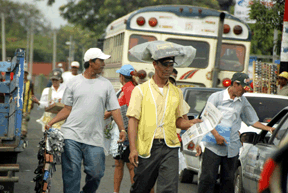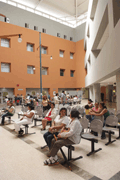“Human security is reflected in a child who doesn’t die, a disease that doesn’t spread, a job that isn’t eliminated, ethnic tension that doesn’t explode into violence, a dissenter who isn’t silenced. Human security doesn’t involve concern about guns but concern about human life and dignity.”
Dr. Mirta Roses Periago
Director, Pan American Health Organization

In 2009–2010, events in the Americas brought into sharp focus the importance and the interconnectedness of health, security, and human well-being. The frightening onset of the H1N1 influenza pandemic tested and largely validated several years of public health preparedness efforts that were grounded in the principles of international health security. The January 2010 earthquake in Haiti showed the tragic consequences of unplanned urban sprawl and the extreme vulnerability of populations living in poverty. Recalling these events, one understands at an intuitive level that human security cannot be taken for granted; it must be protected and promoted as a basic requirement if people, communities, and countries are to carry on in a meaningful way.
The concept of human security has received growing attention in recent years, and not just because of pandemics and natural disasters. Since the end of the Cold War, the number and intensity of armed conflicts among countries has declined dramatically while global interdependence has increased significantly. In this context, the continued suffering and vulnerability of millions of the world’s less advantaged people stand in disturbing contrast to the wealth and comfort of the more privileged. The inherent injustice and instability created by these trends have helped shift the focus of security concerns from the protection of national territory and sovereignty to the protection of human well-being.
This shift was articulated and brought to the fore of the global development agenda by the U.N. Development Program’s (UNDP) Human Development Report 1994. It argued that, in the post–Cold War era, people’s insecurity stems much less from the threat of international conflict than from threats to their daily lives-to their jobs and income, to their health, to their environment, and from crime. This calls for a new approach to security, one that addresses the full range of threats to people’s well-being.
The idea that human security is as critical for peace and development as military security is not new. The importance of both was recognized by the founders of the United Nations. After attending the U.N. Charter conference in San Francisco in 1945, the then U.S. secretary of state told his government:
The battle of peace has to be fought on two fronts. The first is the security front where victory spells freedom from fear. The second is the economic and social front where victory means freedom from want. Only victory on both fronts can assure the world of an enduring peace….No provisions that can be written into the Charter will enable the Security Council to make the world secure from war if men and women have no security in their homes and their jobs.
The idea of a “human” side to security lost ground during the Cold War decades, but re-emerged with the UNDP’s 1994 report. It acknowledged the difficulty of providing a rigorous definition of human security but proposed four essential characteristics of the concept:

The report outlined two types of threats to human security: chronic ones such as hunger, disease, and repression, and threats that are sudden and cause harmful disruptions to daily life. Failure to provide protection from both these kinds of threats can impede human development and lead to social conflict and even violence. In this way, human security-security for people in their daily lives-is also clearly related to collective security and to the state.
At the 2000 Millennium Summit, U.N. Secretary–General Kofi Annan spoke of the importance of “freedom from fear” as well as “freedom from want,” invoking the concept of human security to motivate rich and poor countries to work together to reduce human deprivation. Although the subsequent Millennium Development Goals (MDGs) focused on the latter, the summit called for the creation of an independent Commission on Human Security to explore the former. That commission’s 2003 report, Human Security Now, called for a paradigm shift and a stronger and more integrated response to these issues from communities and states.
The Commission on Human Security’s report reaffirmed and elaborated the view that “freedom from fear” and “freedom from want” are equally important. But it also emphasized the empowering function of people-centered security, noting that it also meant “freedom to take action on one’s own behalf.” Human security means protecting “the vital core of all human lives in ways that enhance human freedoms and human fulfillment.” It means more than the absence of conflicts; it means creating systems- political, social, environmental, economic, military, and cultural-that give people the building blocks of survival, livelihood, and dignity.
The 2007 World Health Report, A Safer Future: Global Public Health Security in the 21st Century, showed how growing interdependence and increased mobility have increased the vulnerability of people around the world to new and emerging threats such as epidemic outbreaks, acts of terrorism, and chemical or radioactive events. The report stressed the importance of countries’ working collectively to protect their populations from such threats through the International Health Regulations and similar mechanisms as well as through increased investments in public health and safety.
In the Americas, the concept of human security emerged on the hemispheric agenda early this decade, as the Organization of American States addressed new threats to regional security such as organized crime, terrorism, environmental degradation, and climate change. In the 2002 Declaration of Bridgetown, OAS Member States recognized the “multidimensional” nature of hemispheric security, noting its political, economic, social, health, and environmental components. In the 2003 Declaration on Security in the Americas, the countries declared that “the basis and purpose of security is the protection of human beings.”
 As part of these deliberations, PAHO was asked to participate in a working group of the Committee on Hemispheric Security, to advise on matters related to health. PAHO produced a report, Health and Hemispheric Security, which argued that “health is a national and international security interest” and an intrinsic part of human security; better health leads to greater human security, and greater human security leads to better health and quality of life. It also explored the interrelatedness of health and other components of human security, particularly poverty, democracy and peace, the environment, and disasters, both natural and man–made. It noted that people’s health depends not only on health care and disease prevention systems but on social determinants such as education, income, access to essential resources, social and political participation, and the environment.
As part of these deliberations, PAHO was asked to participate in a working group of the Committee on Hemispheric Security, to advise on matters related to health. PAHO produced a report, Health and Hemispheric Security, which argued that “health is a national and international security interest” and an intrinsic part of human security; better health leads to greater human security, and greater human security leads to better health and quality of life. It also explored the interrelatedness of health and other components of human security, particularly poverty, democracy and peace, the environment, and disasters, both natural and man–made. It noted that people’s health depends not only on health care and disease prevention systems but on social determinants such as education, income, access to essential resources, social and political participation, and the environment.
This view of health and its interrelatedness with other aspects of human security echoes the holistic vision of the MDGs, which recognize the interdependence of health and political, economic, social, and cultural factors in determining human well–being. This view was elaborated from a public health perspective in the 2008 report of the WHO Commission on the Social Determinants of Health. It urged rich and poor countries alike to reduce inequities in the distribution of power, money, and resources, and to work on all fronts to improve people’s daily living conditions-including the circumstances in which they are born, grow, live, work and age. Though its focus was on health and social justice, the report provided strong analyses of the many components of human security along with valuable recommendations for addressing them.
In these and more recent discussions, the main components of human security fall into seven major areas: economic, food, environmental, personal, community, political, and health. From a public health perspective, however, all seven of these areas include threats to, components of, or determinants of health, and all are amenable to public health interventions. Indeed, PAHO’s ongoing technical cooperation encompasses all these areas. Chapter 2 provides examples of this work in PAHO member countries during 2009–10.